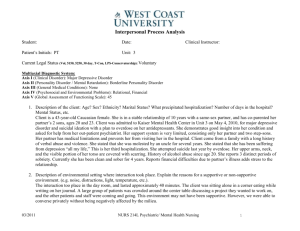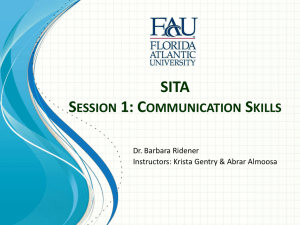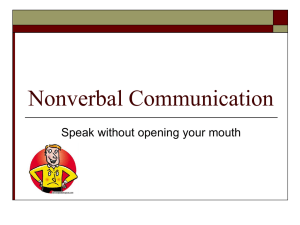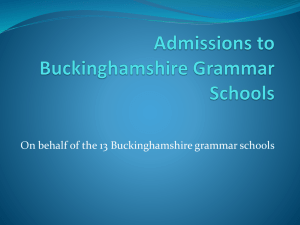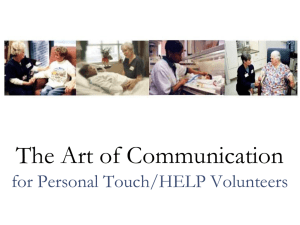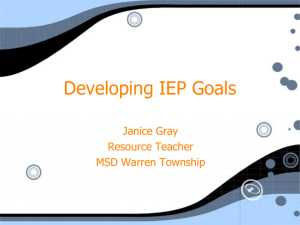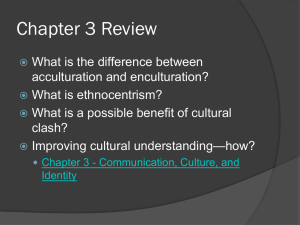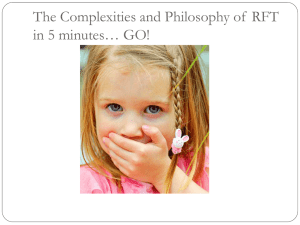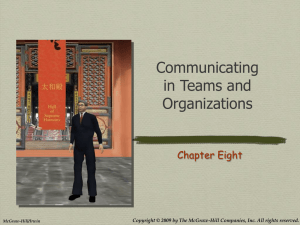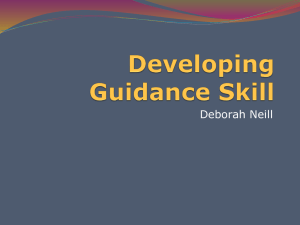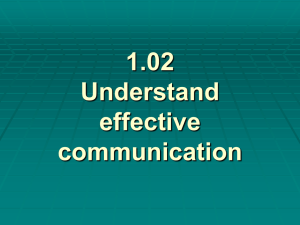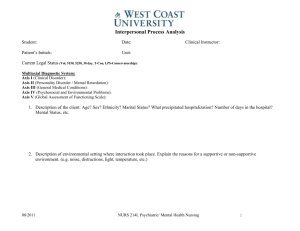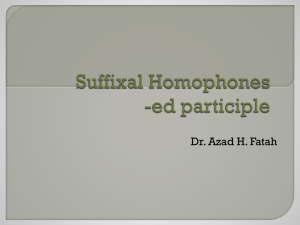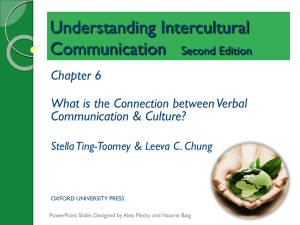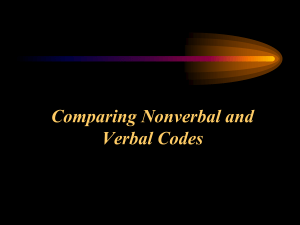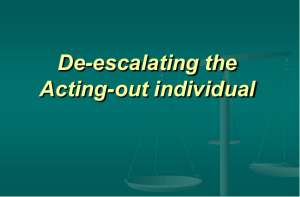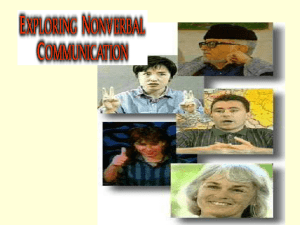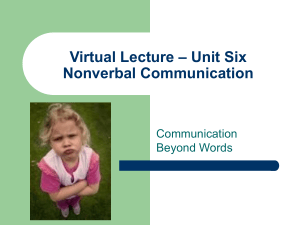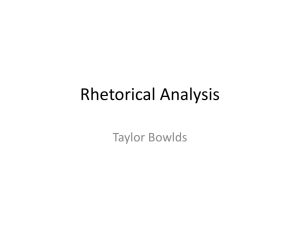Communication
advertisement
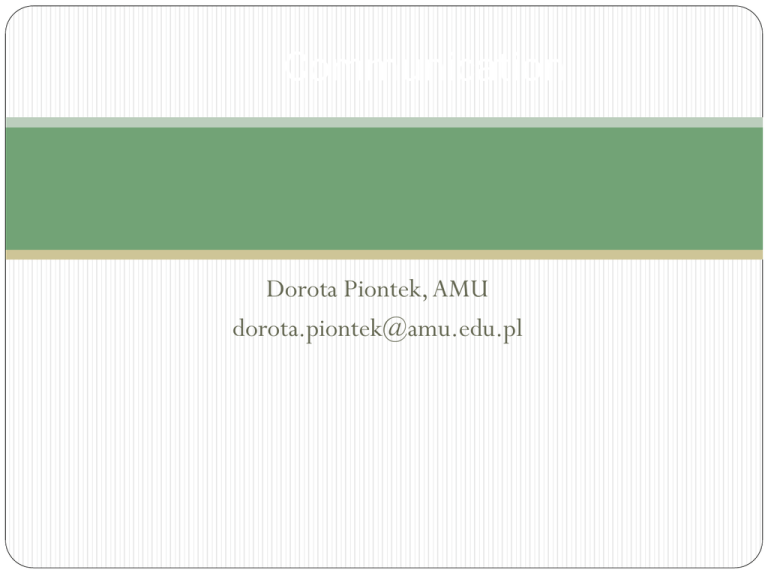
Communication Dorota Piontek, AMU dorota.piontek@amu.edu.pl schedule communication in general interview – how to prepare workshop communication as a process communication is a process in which people share information, ideas, and feelings basic elements of communication: senders and receivers messages channels feedback setting senders and receivers senders - receivers send and receive messages simultaneously message is made up of the ideas and the feelings to be shared are represented by symbols symbols – that stand for sth else symbols: verbal and nonverbal verbal symbols: concrete and abstract channels route traveled by a message between the senders-receivers senses and technical means feedback response of the receivers-senders to each other immediate and delayed noise interference that keeps a message from being understood or accurately interpreted three kinds of noise: physical semantic psychological setting where the communication occures (the surrounding) is made up of several components principles of transactional communication participation is continuous and simultaneous all communications have a past, present, and future all communicators play roles types of communication intrapersonal interpersonal small-group communication institutional communication mass communication intrapersonal communication occures within a person is centered in the self – one is the only sender-receiver message – thoughts and feelings channel: one’s brain social experience interpersonal communication -one to one or a few - each functions as a sender-receiver - verbal and nonverbal symbols - channels: all senses - immediate feedback small-group communication each has a chance to interact with all more complicated, more chance for confusion usually to solve a problem messages more structured channels: all senses immediate feedback institutional/organizational communication e.g. political system or business firm complicated and indirect delayed feedback messages structured formal and informal channels need for technical devices mass communication delivering information, ideas, and attitudes to a sizable, diversified audience through use of media designed for that purpose professional communicator mass audience highly structured message delayed feedback barriers to effective communication selective attention, distortion, and recall channel noises psychological noise language noise fields of experience value judgements mis-matching selectivity barriers to effective communication status differences time constraints overload verbal communication symbol – stands for the object or concept that it names denotative meaning – dictionary definition connotative meaning – feelings or associations one has about a word meanings are determined by people, not by words language environment people their purpose the rules the actual talk language ritual appropriate specialization role and verbal image style – result of the way we select and arrange words and sentences verbal style – connected with the role instrumental vs expressive language improving verbal communication what do you want to say how do you want to say it to whom are you talking metatalk metatalk the meaning exists on three levels: what the speaker is saying what the speaker intends to say what the listener thinks speaker is saying metatalk how are you / how do you do true meaning hello; does not have a meaning – tell me, how have you really been metatalk call me true meaning don’t bother me now; I would accept if you asked me out; I can’t discuss this here; don’t go so fast metatalk I’ll call you true meaning let’s start something; don’t call me let’s have lunch social acquaintances: if you have nothing to do and I have nothing to do – let’s get together; business: if you have sth useful to say to me I’ll listen let’s have dinner social: let’s advance this friendship; business: let’s turn this into a friendship metatalk we must get together I like you but I’m too busy now to take on more friendship I can’t make the time to see you we really must see more often we must do this more often true meaning I can’t make the time to see you we must do this more often this was surprisingly enjoyable, but it still going to happen infrequently I only say what I really mean I’m about to insult you nonverbal communication any information communicate without using words little or no control involves several related messages need to know a person verbal and nonverbal differences functions of nonverbal communication to complement a verbal message to regulate verbal communication to substitute for verbal message to accent what sb’s saying principles of nonverbal communication is culturally determined may conflict with verbal messages is largely unconscious is important in communicating feelings and attitudes types of nonverbal communication paralanguage body movement body type attractiveness body adornment space and distance touch time paralanguage – the use of voice rate (speed) – varying is important pitch (highness or lowness) – middle in pitch is the best volume – change good for attention vocal fillers body movements emblems illustrators regulators display of feelings adaptors body body type attractiveness body adornment space and distance - proxemics intimate distance personal distance social distance public distance touch and time cultural differences inter-cultural communication - barriers ethnocentrism prejudice stereotypes uncertainty wrong interpretation of non-verbal communication language types of cultures - Geert Hofstede 1. 2. 3. 4. four dimensions of culture: distance towards authorities: small vs huge collectivism vs individualism: collective vs individualistic musculine vs feminine: male vs female avoiding uncertainty: open vs close power vs distance the degree to which the less powerful members of a society accept and expect that power is distributed unequally fundamental issue here: how a society handles inequalities among people people in societies exhibiting a large degree of power distance accept a hierarchical order in which everybody has a place and which needs no further justification in societies with low power distance, people strive to equalise the distribution of power and demand justification for inequalities of power individualism vs collectivism individualism - a preference for a loosely-knit social framework in which individuals are expected to take care of themselves and their immediate families only collectivism - a preference for a tightly-knit framework in society in which individuals can expect their relatives or members of a particular in-group to look after them in exchange for unquestioning loyalty a society's position on this dimension is reflected in whether people’s self-image is defined in terms of “I” or “we.” masculinity vs femininity masculinity - a preference in society for achievement, heroism, assertiveness and material reward for success; society at large is more competitive femininity - a preference for cooperation, modesty, caring for the weak and quality of life; society at large is more consensus-oriented uncertainty vs avoidance expresses the degree to which the members of a society feel uncomfortable with uncertainty and ambiguity fundamental issue: how a society deals with the fact that the future can never be known: should we try to control the future or just let it happen? countries exhibiting strong UAI maintain rigid codes of belief and behaviour and are intolerant of unorthodox behaviour and ideas weak UAI societies maintain a more relaxed attitude in which practice counts more than principles long/short time orientation can be interpreted as dealing with society’s search for virtue societies with a short-term orientation: a strong concern with establishing the absolute Truth; are normative in their thinking, exhibit great respect for traditions, a relatively small propensity to save for the future, and a focus on achieving quick results societies with a long-term orientation: belief that truth depends very much on situation, context and time; show an ability to adapt traditions to changed conditions, a strong propensity to save and invest, thriftiness, and perseverance in achieving results indulgence vs restraint indulgence - a society that allows relatively free gratification of basic and natural human drives related to enjoying life and having fun restraint - a society that suppresses gratification of needs and regulates it by means of strict social norms lower vs higher context cultures (E. Hall) a culture's tendency to use high context messages over low context messages in routine communication a high context culture: many things are left unsaid, letting the culture explain; words and word choice become very important in higher context communication, since a few words can communicate a complex message very effectively to an in-group (but less effectively outside that group) a lower context culture: the communicator needs to be much more explicit and the value of a single word is less important lower vs higher context cultures lower context culture: Australian, English Canadian, English, Finnish, German, Irish, New Zealand, Scandinavia, Switzerland, United States (excluding the Southern United States) higher context culture: African, Arab, Brazilian, Chinese, Filipinos, French, Canadian French, Greek, Hawaiian, Hungarian, Indian, Indonesian, Italian, Japanese, Korean, Latin Americans, Portuguese, Russian, Polish, Southern United States, Spanish, Thai, Turkish, Vitnamese, South Slavic cross-cultural communication task prepare to interview: - applicants – cv and motivation letter - recuirement staff – selection of 5 applicants to the further interview motivation letter introduce yourself be clear about position you’re applying for give good reasons for your application give good arguments that you are the best choice hand-written signiture not longer than ¾ of a page interview homework information about the organization important attributes first impression body language homework job description and general information position salary department – in large or medium organization location description of the main resposibilities of the position homework objectives key tasks personal specification social issues information about the organization whatever you can have a „larger picture” of the history, aims, and corporate values important attributes communication skills personal presentation self-motivation first impression up to 1 min personal presentation confidence and assertivness preparation communication skills enthusiasm for the position punctuality eye contact impressive application/C.V. body language greet the interviewer sit comfortably keep an eye contact pause to think smile
